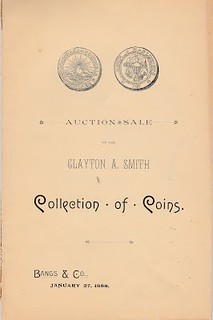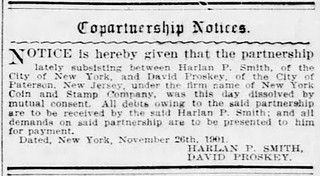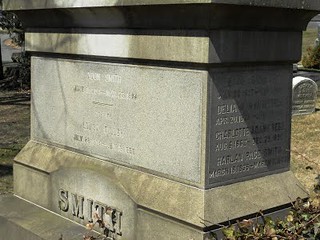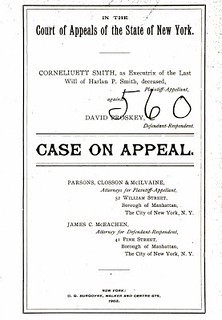
PREV ARTICLE
NEXT ARTICLE
FULL ISSUE
PREV FULL ISSUE
HARLAN PAGE SMITH (1839-1902)
John Lupia submitted the following information from his Encyclopedic Dictionary of Numismatic Biographies for this week's installment of his series. Thanks! As always, this is an excerpt with the full article and bibliography available online. This week's subject is
New York dealer Harlan Page Smith.
-Editor
Harlan Page Smith (1839-1902), was born on March 18, 1839 in Hamilton, Madison County, New York, son of Adon Smith (1804-1874) and Louisa M. Fuller (1804-1860). His father Adon inherited a fortune in real estate scattered in several states together with his brother Sidney Smith from their half brother Jonathan Hunt, who died in 1847. Adon sold a portion of the land from that estate in Alabama amounting to $148,470.85, leaving no accounting to other heirs of the estate. Lawsuits ensued after the death of Adon's brother Sidney Smith, who died in 1886 at a lunatic Asylum. The lawsuits from 1888 to 1892, involved Harlan Page Smith regarding the real estate and monies of the estate for over $1,000,000. In Smith's unflattering obituary in the May 1902 issue of The Numismatist his physical appearance is described as repellent. Another writer years later described him more generously as "Hale and Hardy". Though robust he was probably not attractive in visage. Probably for this reason we do not find photographic images of Smith. A curious tale is reported about his early career in his obituary by Lyman Haynes Low in American Journal of Numismatics, July (1902) : 31, claiming he was a mariner and fruit dealer who retired in 1876 to study and sell coins, when in actuality he was a real estate tycoon and American Aristocrat. In 1852 he married Corneliuett Pudney (1839- 1923), daughter of John Cornelius Pudney (1817-1875) and Mary Harrow (1818-1840). In 1870 and 1880, the U. S. census lists his profession as a Real Estate agent in New York City, New York (nothing fruity about that); and two daughters Ella Grace Smith (1860-1938), and Charlotte Adams Smith (1862-1890). Smith was an affluent landlord and held many properties and certainly helped his father manage their real estate portfolio, selling off some properties for various reasons. Hence, the occupational description of "Real Estate agent." It is uncertain when his interest and passion for collecting rare gem coins began, but it more likely than not predated Low's eulogy citing 1876, and probably extended back to his school days in the 1850's, which for most schoolboys consisted in collecting Ancient Greek and Roman coins from their study of ancient languages and history. In 1880, he formed a short-lived partnership with Henry Griswold Sampson (1840-1899), in the firm of H. P. Smith and H. G. Sampson. The firm lasted a little over a year and produced four coin auction sale catalogues. In the Fall of 1881 Smith fancied himself a coin dealer or at least projected that image of himself and began to produce his own series of at least twenty-four to twenty-six coin auction sale catalogues from 1881 to 1887, at least twenty-two to twenty-four held in New York, and two in London, England. We do not know if they were all actually produced by him, or perhaps, more likely by a ghost writer like Edouard Frossard, Joseph Sabin or George Cogan, well-known catalogers who worked for Bangs & Company. All of Smith's coin auction sales were held at the Bangs Auction House. The possibility of Frossard being the ghost writer is strengthened by his signature sardonic witty sarcasm as that found in the coin auction catalogue of the Walter Hubbard sale, for example, held on July 12th through 13th, 1883, at Bangs & Company, New York. Frossard probably authored the catalogues from 1881 to 1884. Moreover, he held two more coin auction sales in London, England, and those catalogues were devised by the catalogers working for Sotheby. Furthermore, David Proskey alleged in Mrs. Smith's lawsuit of 1902 that he was a copartner with Smith for more than fifteen years, which would make him a silent partner in the supposedly sole proprietorship of Harlan Page Smith's coin dealership from about 1885 to 1887.


LEFT: Smith & Sampson 1-7-1881 Sale RIGHT: The first coin auction catalogue of the firm of New York Coin & Stamp Company January 27,1888 Clayton Smith Sale In 1887, he formed a partnership with David U. Proskey (1853-1928) of Wappinger Falls, New York, in the firm of New York Coin and Stamp Company. Smith operated out of New York and Proskey usually from New Jersey, where he lived variously in Little Falls, and also at Patterson, and later in life at North Caldwell, New Jersey. However, they did have an office and coin shop in New York located at 853 Broadway, in the Singer Building, and after the dissolution of the partnership from about 1907 to 1926 at 11 West 30th Street, New York City, New York, and finally from 1926 to 1928, at 912 6th Avenue, which were managed by Proskey. After Proskey's death his son David V. Proskey continued the company with the same name at the Little Falls, New Jersey address running full page ads in The Numismatist in 1929 and seems to have been bought out by F.C.C. Boyd after Black Thursday, October 24, and Tuesday, October 29, 1929. Smith's role was treasurer, and predominantly the silent partner, i.e., the financier of the company leaving Proskey as the buyer, seller and manager with the corporate title, President. Smith collected by cherry picking the gems Proskey brought in.

Announcement of the dissolution of Smith's partnership with Proskey
This lawsuit went back and forth filing motion after motion in a long protracted hearing, which always seemed to skirt the real issue of Mrs. Smith is that she had neither any inventory of the safes, nor way of knowing who owed her husband's company money nor how much, which Proskey had access to the four safes knowing the combinations; and consequently no objective authoritative accounting existed for her peace of mind and was forced to merely take Proskey at his word. Mrs. Smith was keenly aware of the value of rare coins, gold coins, etc., which she knew filled the safes, besides outstanding invoices of buyers who owed the firm money. Prior to any coin auction sale in America the Ancient Greek and Roman part of his coin collection was sold posthumously by Sotheby, London, England, on June 5, 1905. On January 26, 1906 and February 6, 1906, the remaining two British held coin auctions took place in London which comprised smaller lots as supplements to those auctions. The January supplement comprised of British war medals. That of February were some remaining Ancient and foreign pieces. Other portions of his coin collection were sold by the Chapman Brothers on May 8-11, and another on June 29, 1906, at Davis & Harvey. In the first Chapman sale of May 8-11th, the 2,416 lots realized $22,615.10. Among the lots, lot 836 a Gem Proof 1856 Quarter Dollar purchased by John H. Clapp, and lot 951, an 1844 Proof Liberty Seated Dime, and also in another lot, number 210, an 1822 Capped Head Facing Left Half Eagle sold to William Forrester Dunham of Chicago, Illinois for $2,165. At that time it was the highest price ever paid for a U. S. coin.
See the full article for many more illustrations and notes.
-Editor
To read the complete article, see:
The Numismatic Bibliomania Society is a non-profit organization promoting numismatic literature. See our web site at coinbooks.org. To submit items for publication in The E-Sylum, write to the Editor at this address: whomren@gmail.com To subscribe go to: https://my.binhost.com/lists/listinfo/esylum All Rights Reserved. NBS Home Page Contact the NBS webmaster 
|

